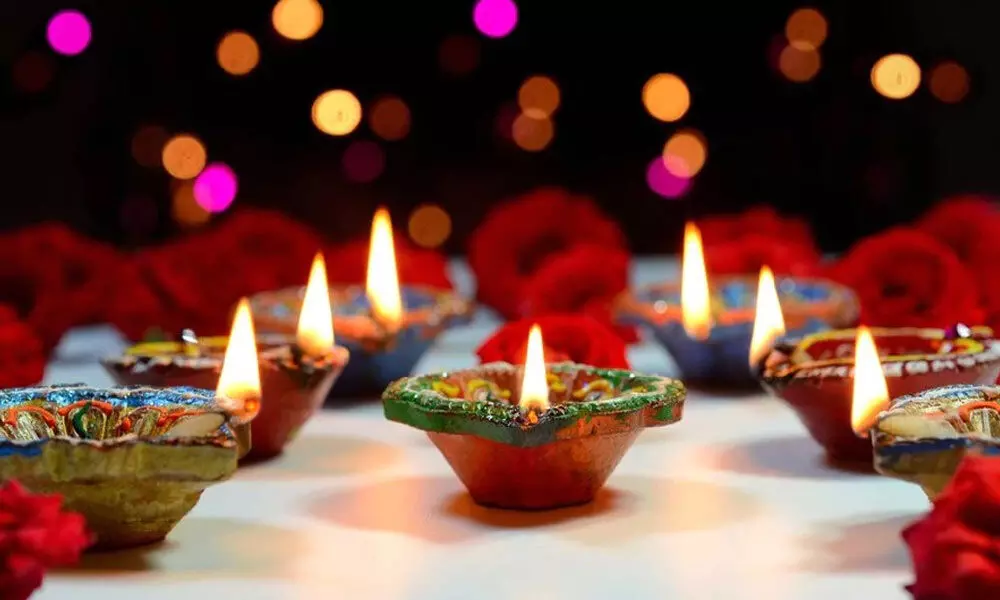Live
- Five-Year-Old Boy Dies After 55-Hour Rescue from Borewell in Rajasthan's Dausa
- Chaos in Parliament over Congress-George Soros link claims, BJP MP poses questions
- Bus Driver Arrested After Deadly Accident in Mumbai’s Kurla; 42 Injured
- Community lunch, a ritual to prevent drought in Adoni
- Rs 36.07 crore tribal products sold through TRIFED in FY24: Govt
- PM Modi to lay foundation stone for Ken-Betwa river linking project on Dec 25: MP CM
- 70 farmers trained as drone pilots in Anantapur dist
- AP Pensions: 500 Ineligible People Receive Pensions for Every 10,000
- South Korea's ruling party chief voices support for President Yoon's impeachment
- Defeat in Tirhut bypolls doesn't signify discontent among teachers: Bihar Education Minister
Just In

Untold secrets of Diwali
Ask the present generation, or even a generation earlier, the meaning of Dhanteras.
Ask the present generation, or even a generation earlier, the meaning of Dhanteras. One hears fantastic explanations and everyone would vouch by the Vedas and the Shastras that their explanation is correct. According to them, this day is majorly celebrated for shopping utensils, gold and silver. Some would say Dhanteras, also known as Dhanvantari Trayodashi, marks the beginning of Diwali festival. The word 'Dhan' means wealth and 'teras' translates to 13th day of lunar month of Krishna Paksha in the Hindu calendar.
The legend they would claim is on this day Goddess Lakshmi emerged out of the ocean during the Sagar Manthan (churning of the milky sea) along with Lord Kubera, the God of wealth, and hence the two are worshipped on the auspicious day of Trayodashi. So, people should buy gold, silver, brass and copper items, electronics and home appliances, broom (symbol of cleanliness), new property or land, or even open a bank account.
Incidentally, none of these finds any mention in the Vedas or the Shastras or any other scriptures. There were no electronic gadgets those days. But then what exactly is the purpose of Deepawali and what is Dhanteras? According to mystics such as Sadhguru, the real significance of Dhanvantari Trayodashi has been ignored and forgotten. Deepawali comes on the 13th day of Trayodashi. This is the day when people worship the deity of health called 'Dhanvantari' who is the source of Ayurveda. In North, people have the habit of omitting letters in certain words. Shiva becomes Shiv, Rama becomes Ram, Deepawali becomes Diwali etc. Similarly, one does not know when and how Dhanvantari became Dhanteras and what was health became money.
What happens during the month Karthika is that in northern hemisphere things change and life slows down as winter sets in. Dhanvantari had laid out a science to pass through winter months that one does not get into a feeling of sinking. This includes a regimen of what one should do, when he should wake up etc. Lighting of lamps and bursting of crackers was one of those things. This is meant to see that one's body does not get into a tendency to hibernate. During this period, women particularly in rural India, even now, wake up early in the morning, clean front yard of the house and draw different geometrical designs (Muggu or Rangoli) with rice flour every day. Of course, in cities and towns, few people do it but it is mostly with chalk pieces. The majority don't even do that. They either get it painted or a template is fixed on the floor.
Men in groups used to go out singing to the beating of drums. All such activity used to keep their energy levels high even during winter months. The idea behind this was that the first rays of Sun should hit them. Sun, as we all know, is the source of energy. People are asked to eat sweets made of jaggery, sesame etc. Consumption of dry fruits is encouraged so that the immunity levels are well maintained.
But unfortunately, a religious colour has been given to non-religious activities and healthy practices got converted into commercial activities to make the rich richer. It is time we revive the values of the past and see that the focus is back on rejuvenation so that the society stays healthy. Health is, after all, the biggest wealth.

© 2024 Hyderabad Media House Limited/The Hans India. All rights reserved. Powered by hocalwire.com







